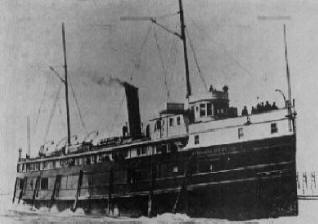Most would agree. The loss of the steamer Chicora on January 21, 1895 remains the single greatest mystery on Lake Michigan.
The steamship Chicora was built for the Graham & Morton Transportation Company by the Detroit Dry Dock Company in 1892. This especially stout ship had been designed for winter passenger and cargo runs between Wisconsin and southern Michigan and had been built to cut through the ice pack and safely ply the often violent waters of the Great Lakes. She had a “guaranteed” speed of 17 miles per hour.
 The Chicora was a wooden hulled vessel, 198.5 feet long at the waterline (209 feet overall), with a 35 foot beam and a depth of 13.6 feet. She was equipped with a forward pilot house, two masts and one smokestack amidships. She boasted a triple expansion engine with #2 Scotch boilers described as 12 feet in diameter and 11.5 feet long. The engine’s cylinder and stroke size was: 20+33+54 x 42″ stroke.
The Chicora was a wooden hulled vessel, 198.5 feet long at the waterline (209 feet overall), with a 35 foot beam and a depth of 13.6 feet. She was equipped with a forward pilot house, two masts and one smokestack amidships. She boasted a triple expansion engine with #2 Scotch boilers described as 12 feet in diameter and 11.5 feet long. The engine’s cylinder and stroke size was: 20+33+54 x 42″ stroke.
In January, 1895 the Chicora had been tied up for the winter at St. Joseph, Michigan when her owners received a request to deliver a shipment of late winter flour from Milwaukee, Wisconsin back to St. Joseph. Captain Edward C. Stines of St. Joseph readied his ship and left for Milwaukee early Sunday morning, January 20. One of the tragic ironies of the voyage occurred when the captain, finding himself short of crew members, signed on his 23 year old son to replace his second mate who was ill.
The next day — an unusually pleasant January 21st found the Chicora ready for the return run across the lake. She left the dock at 5:00 AM — ten minutes ahead of a messenger boy who arrived at the dock with a telegraph from the ship’s owner, John Graham, warning the captain not to sail because the barometer was falling fast at Benton Harbor.
The Chicora would have been about mid lake when the winds shifted to the southwest and began blowing with a typical January fury. Later that day, the ship was reported overdue and telegrams were sent up and down the Michigan coast to alert all harbors to keep a watch for the vessel.
Several eyewitness reports fueled rumors that the ship was in trouble. A South Haven man reported seeing a ship heading toward shore with its stern down and sinking. A vessel was also seen headed for South Haven obviously in trouble and blowing her horn continuously.
When at last the storm subsided, a dozen men from Saugatuck ventured out on to the ice and found a line of wreckage frozen into the ice about 3/4 miles from shore stretching from Saugatuck to South Haven. The newspaper reported an 8 foot square portion of decking, some oars and both masts were found less than 1/2 mile apart.
 During the first week in February a Chicago based tug reported sighting a hulk floating on the open water with crew members still alive! W. J. Hancock, regular clerk of the Chicora who missed the sailing, was sent to the southern part of the lake to investigate. After renting a tug he reported seeing only a dark iceberg covered with seagulls.
During the first week in February a Chicago based tug reported sighting a hulk floating on the open water with crew members still alive! W. J. Hancock, regular clerk of the Chicora who missed the sailing, was sent to the southern part of the lake to investigate. After renting a tug he reported seeing only a dark iceberg covered with seagulls.
No bodies ever were recovered. No wreckage more substantial than superstructure and masts was ever found. The hull of the Chicora lies, most likely fairly intact, at the bottom of Lake Michigan somewhere east of mid lake, between Saugatuck and St. Joseph.
The crew consisted mostly of Michigan men including:
Captain Edward George Stines of St. Joseph, MI
Grant A. Downing, oiler, Lapeer, MI
James R. Clarke, clerk, of St. Joseph, MI
Alfred Downing, coal passer, Lapeer, MI
Cornelius D. Simons, 1st mate, Benton Harbor, MI
Nathan Reeves Lynch, cook, St. Joseph
Benjamin Edward Stines, 2nd Mate, St. Joseph
M. W. Morgan, waiter/steward, Benton Harbor, MI
Joseph Marks, Wheelman, Benton Harbor, MI
James Malone, pantry man, Chicago, IL
Robert Mc Clure, 1st Engineer, Detroit, MI
Jesse Davis, porter, Benton Harbor, MI
Alfred Wirtz, 2nd engineer, Detroit, MI
Thomas Cass, dockhand, Benton Harbor, MI
John Werner, fireman, Sweden
Jack Ryan, dockhand, Benton Harbor, MI
William M. Scheck, fireman, Philadelphia, PA
William Dunn, dockhand, Benton Harbor, MI
Thomas Robertson, watchman, Baltimore, MD
Joseph Felix, dockhand, Benton Harbor, MI
John Hoogeboon, watchman, Saginaw, MI
John Mattison, watchman, Benton Harbor, MI
Joseph F. Pearl, passenger, of St. Joseph, MI
The masts from the Chicora were skidded across the ice to shore by Christopher Schultz and sons and the Wark boys of Douglas. They were given to the Village of Douglas and on March 1, 1895 were dedicated as the new Douglas Village flag pole. The pole remained in Douglas for about 40 years before being discarded in the 1930s due to rot. It is currently on display at the Allegan Museum.
As spring arrived and the ice thawed, more wreckage was discovered in including a chair from the engine room used by Chief Engineer Mc Clure. On April 14, a bottle washed ashore with a message that read, “All is lost, could see land if not snowed and blowed. Engine give out, drifting to shore in ice. Captain and clerk are swept off. We have a hard time of it. 10:15 o’clock.”
A week later a jar washed up in Glencoe, Illinois with a note written on paper from a small pocket notebook. The note read, “Chicora engines broke. Drifted into trough of sea. We have lost all hope. She has gone to pieces. Good bye. Mc Clure, Engineer.”
Were these notes legitimate or hoaxes? We may never know.
Since the late 1990s, MSRA has conducted annual searches of the bottomlands of Lake Michigan searching for “ships gone missing.” To say the Chicora was at the top of the “most wanted” list, would not be an exaggeration.


